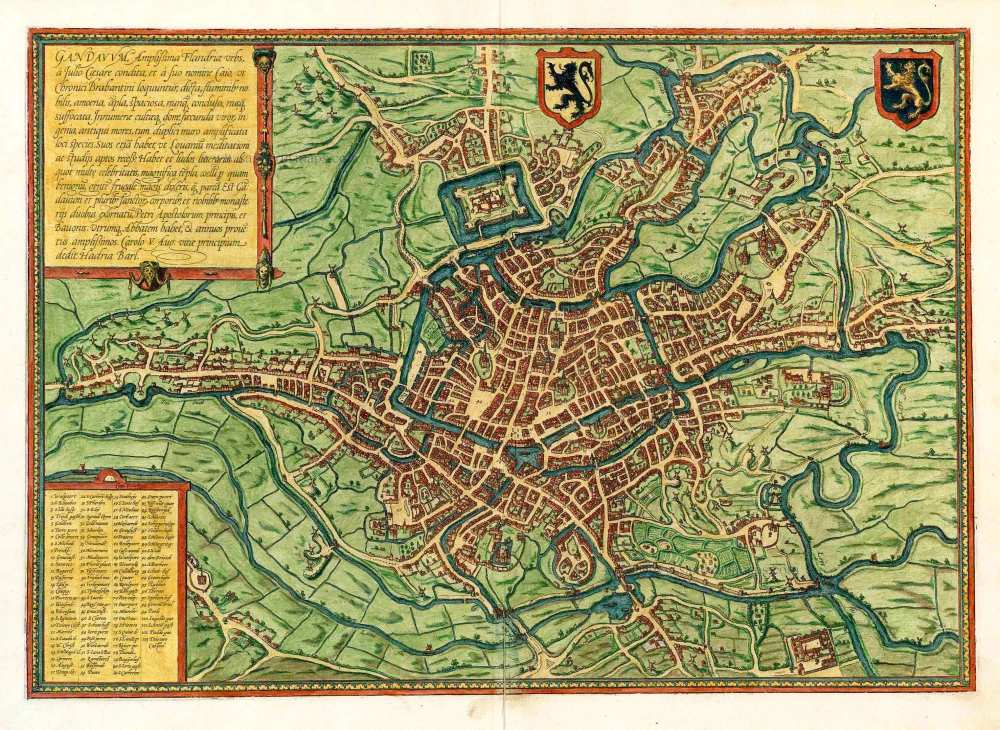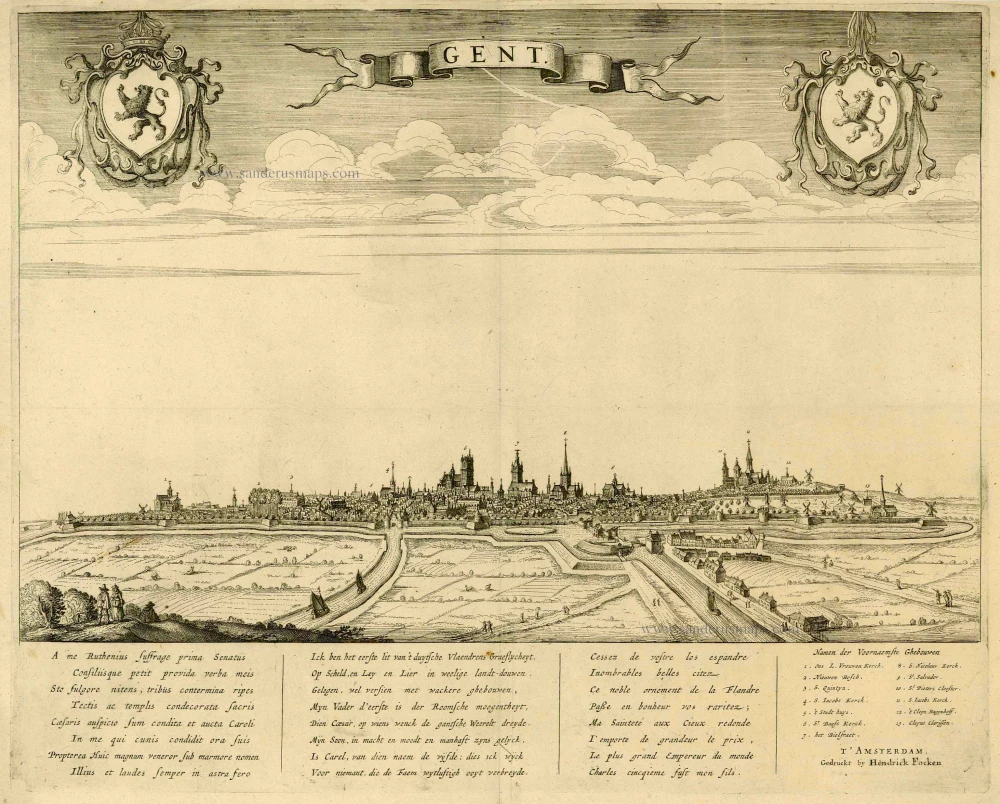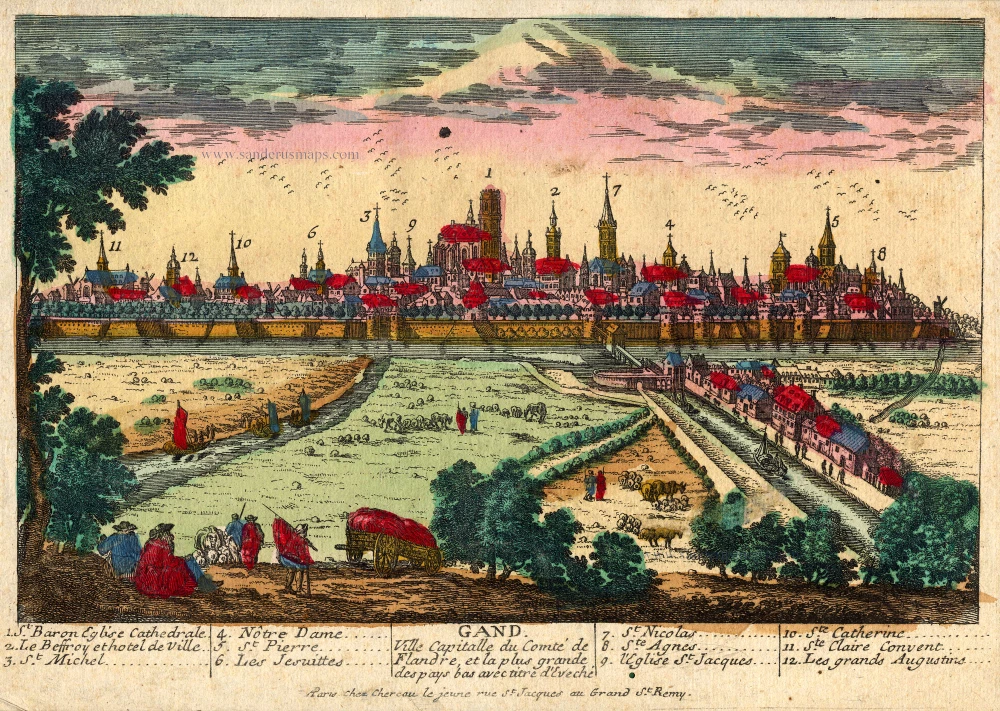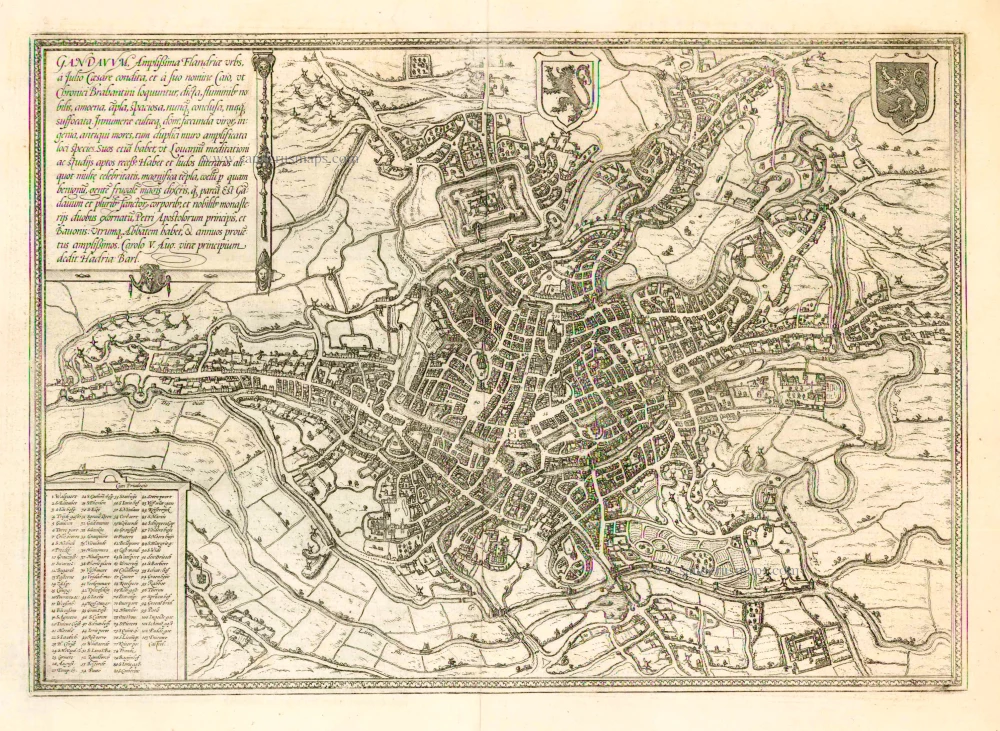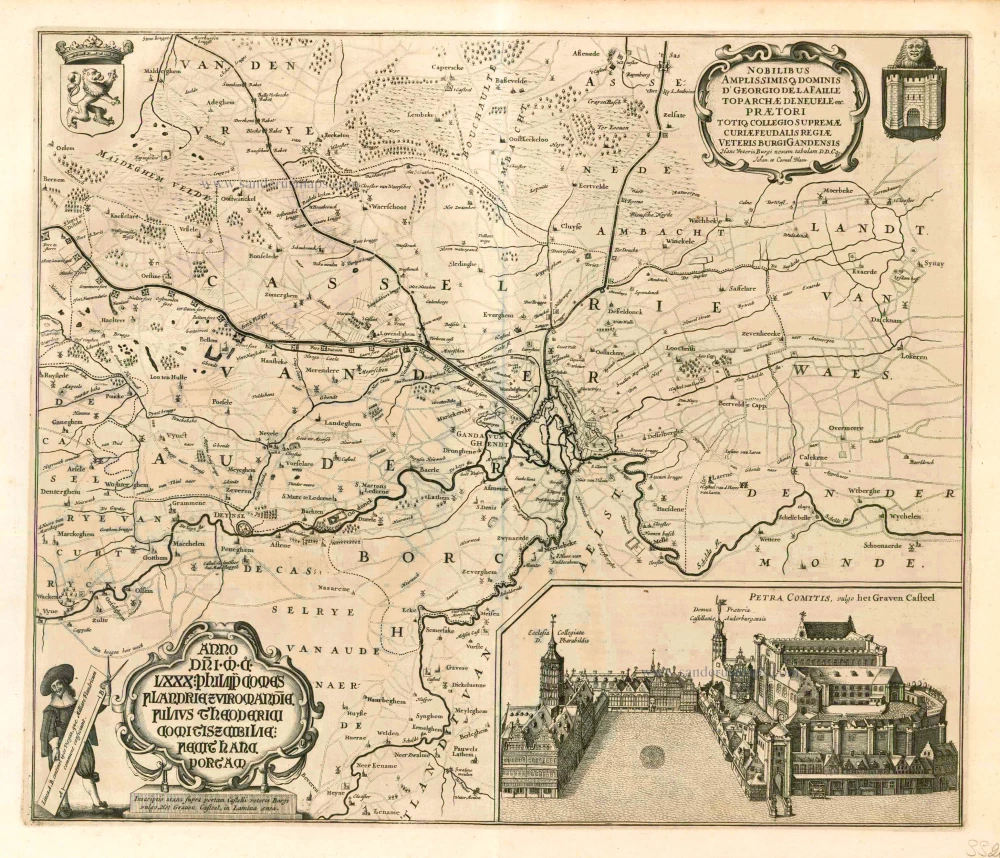GENT by Georg Braun & Frans Hogenberg 1572
TRANSLATION OF CARTOUCHE TEXT: Ghent, the most splendid city in Flanders, was founded by Julius Caesar and called Gaius after his forename, as the Brabant chroniclers relate. The city is distinguished by its rivers, altogether delightful, magnificent, spacious, never confined, nowhere stifling. The houses are innumerable and well-kept, the men richly talented, the customs venerable. A double wall amplifies the beautiful appearance of the place, which - like Louvain - also has quiet corners for reflection and study. Ghent also possesses famous schools and magnificent churches; the climate is excellent. The people, it can be said, are more frugal than parsimonious. Ghent is embellished by the relics of several saints and two famous monasteries dedicated to St Peter, Prince of the Apostles, and St Bavo; each has an abbot and a sizeable annual rental income.
COMMENTARY BY BRAUN: "Ghent has a circumference of three German miles, possesses 20 islands, which lie in the surrounding lakes and rivers and are also inhabited, 98 bridges, including three that have more than two spans and beneath which even the biggest ships can pass. There are 100 windmills that can grind even the largest produce. In this city alone there are seven parish churches, five abbeys, two collegiate churches, 25 monasteries and seven general hospices. On the site where the new castle now stands, lay in olden times the village of Ganden, from which the city also took its name, and a magnificent Benedictine monastery of St Bavo, which was constructed from an old fortress and which in 1540 was enlarged by Emperor Charles V into an even bigger palace."
The view of Ghent shows the city from the northwest in plan view from a great height. The historical core of the city occupies the peninsula between the two Rivers Schelde and Leie. The cathedral of Sint-Baafs (51) is almost at the very centre of the map: it houses the famous Ghent Altarpiece painted by Hubert and Jan van Eyck. Together with the Gothic church of Sint-Niklaas (57) lower down and the nearby Sint-Jacobskerk (43), Sint-Baafs serves as one of the three main orientation points inside the city centre. Within this triangle stands the 14th-century belfry (55), 118 m high, which forms part of the cloth hall. The former Sint-Baafs monastery lies somewhat outside the city centre and is surrounded by fortifications and moats (103). Ghent, which is situated to the northwest of Brussels, derives its name from the Celtic ganda , meaning "confluence". As a leading centre of cloth production, in the High Middle Ages, Ghent rose to become a major power with a flourishing economy and together with Bruges was the most important centre of commerce in Flanders. From the 13th to the middle of the 14th century Ghent was the second-largest city in northern Europe after Paris, with some 60,000 inhabitants, but in the second half of the 14th century these numbers began to decline. Flemish-speaking Ghent is today the third-largest city in Belgium, with a population of around 230,000. (Taschen)
Braun G. & Hogenberg F. and the Civitates Orbis Terrarum.
The Civitates Orbis Terrarum, or the "Braun & Hogenberg", is a six-volume town atlas and the most excellent book of town views and plans ever published: 363 engravings, sometimes beautifully coloured. It was one of the best-selling works in the last quarter of the 16th century. Georg Braun wrote the text accompanying the plans and views on the verso. Many plates were engraved after the original drawings of a professional artist, a professional artist, Joris Hoefnagel (1542-1600). The first volume was published in Latin in 1572, and the sixth in 1617. Frans Hogenberg created the tables for volumes I through IV, and Simon van den Neuwel made those for volumes V and VI. Other contributors were cartographers Daniel Freese and Heinrich Rantzau. Works by Jacob van Deventer, Sebastian Münster, and Johannes Stumpf were also used. Translations appeared in German and French.
Following the original publication of Volume 1 of the Civitates in 1572, seven further editions of 1575, 1577, 1582, 1588, 1593, 1599 and 1612 can be identified. Vol.2, first issued in 1575, was followed by further editions in 1597 and 1612. The subsequent volumes appeared in 1581, 1588, 1593, 1599 and 1606. The German translation of the first volume appeared from 1574 on, and the French edition from 1575 on.
Several printers were involved: Theodor Graminaeus, Heinrich von Aich, Gottfried von Kempen, Johannis Sinniger, Bertram Buchholtz and Peter von Brachel, who all worked in Cologne.
Georg Braun (1541-1622)
Georg Braun was born in Cologne in 1541. After his studies in Cologne, he entered the Jesuit Order as a novice. 1561, he obtained his bachelor's degree, and in 1562, he received his Magister Artium. Although he left the Jesuit Order, he studied theology, gaining a licentiate in theology.
Frans Hogenberg (1535-1590)
Frans Hogenberg was a Flemish and German painter, engraver, and mapmaker. He was born in Mechelen as the son of Nicolaas Hogenberg.
By the end of the 1560s, Frans Hogenberg was employed upon Abraham Ortelius's Theatrum Orbis Terrarum, published in 1570; he is named an engraver of numerous maps. In 1568, he was banned from Antwerp by the Duke of Alva and travelled to London, where he stayed a few years before emigrating to Cologne. He immediately embarked on his two most important works, the Civitates, published in 1572 and the Geschichtsblätter, which appeared in several series from 1569 until about 1587.
Thanks to large-scale projects like the Geschichtsblätter and the Civitates, Hogenberg's social circumstances improved with each passing year. He died as a wealthy man in Cologne in 1590.
Gandavum, Amplissima Flandriae urbs, ...
Item Number: 27026 Authenticity Guarantee
Category: Antique maps > Europe > Belgium - Cities
Old, antique bird's-eye view plan of Ghent, by Georg Braun and Frans Hogenberg.
Oud antiek plan in vogelperspectief van Gent, door Georg Braun en Frans Hogenberg.
Date of the first edition: 1572
Date of this map: 1572
Copper engraving, printed on paper.
Size (not including margins): 34 x 48.5cm (13.3 x 18.9 inches)
Verso text: Latin
Condition: Hand coloured, excellent.
Condition Rating: A+
References: Van der Krogt 4, #1503 State 1; Taschen, Br. Hog. p.72; Fauser, #4545.
From: Civitates Orbis Terrarum, Liber Primus. Cologne, Theodor Graminaeus, 1572. (Van der Krogt 4, 41:0)
TRANSLATION OF CARTOUCHE TEXT: Ghent, the most splendid city in Flanders, was founded by Julius Caesar and called Gaius after his forename, as the Brabant chroniclers relate. The city is distinguished by its rivers, altogether delightful, magnificent, spacious, never confined, nowhere stifling. The houses are innumerable and well-kept, the men richly talented, the customs venerable. A double wall amplifies the beautiful appearance of the place, which - like Louvain - also has quiet corners for reflection and study. Ghent also possesses famous schools and magnificent churches; the climate is excellent. The people, it can be said, are more frugal than parsimonious. Ghent is embellished by the relics of several saints and two famous monasteries dedicated to St Peter, Prince of the Apostles, and St Bavo; each has an abbot and a sizeable annual rental income.
COMMENTARY BY BRAUN: "Ghent has a circumference of three German miles, possesses 20 islands, which lie in the surrounding lakes and rivers and are also inhabited, 98 bridges, including three that have more than two spans and beneath which even the biggest ships can pass. There are 100 windmills that can grind even the largest produce. In this city alone there are seven parish churches, five abbeys, two collegiate churches, 25 monasteries and seven general hospices. On the site where the new castle now stands, lay in olden times the village of Ganden, from which the city also took its name, and a magnificent Benedictine monastery of St Bavo, which was constructed from an old fortress and which in 1540 was enlarged by Emperor Charles V into an even bigger palace."
The view of Ghent shows the city from the northwest in plan view from a great height. The historical core of the city occupies the peninsula between the two Rivers Schelde and Leie. The cathedral of Sint-Baafs (51) is almost at the very centre of the map: it houses the famous Ghent Altarpiece painted by Hubert and Jan van Eyck. Together with the Gothic church of Sint-Niklaas (57) lower down and the nearby Sint-Jacobskerk (43), Sint-Baafs serves as one of the three main orientation points inside the city centre. Within this triangle stands the 14th-century belfry (55), 118 m high, which forms part of the cloth hall. The former Sint-Baafs monastery lies somewhat outside the city centre and is surrounded by fortifications and moats (103). Ghent, which is situated to the northwest of Brussels, derives its name from the Celtic ganda , meaning "confluence". As a leading centre of cloth production, in the High Middle Ages, Ghent rose to become a major power with a flourishing economy and together with Bruges was the most important centre of commerce in Flanders. From the 13th to the middle of the 14th century Ghent was the second-largest city in northern Europe after Paris, with some 60,000 inhabitants, but in the second half of the 14th century these numbers began to decline. Flemish-speaking Ghent is today the third-largest city in Belgium, with a population of around 230,000. (Taschen)
Braun G. & Hogenberg F. and the Civitates Orbis Terrarum.
The Civitates Orbis Terrarum, or the "Braun & Hogenberg", is a six-volume town atlas and the most excellent book of town views and plans ever published: 363 engravings, sometimes beautifully coloured. It was one of the best-selling works in the last quarter of the 16th century. Georg Braun wrote the text accompanying the plans and views on the verso. Many plates were engraved after the original drawings of a professional artist, a professional artist, Joris Hoefnagel (1542-1600). The first volume was published in Latin in 1572, and the sixth in 1617. Frans Hogenberg created the tables for volumes I through IV, and Simon van den Neuwel made those for volumes V and VI. Other contributors were cartographers Daniel Freese and Heinrich Rantzau. Works by Jacob van Deventer, Sebastian Münster, and Johannes Stumpf were also used. Translations appeared in German and French.
Following the original publication of Volume 1 of the Civitates in 1572, seven further editions of 1575, 1577, 1582, 1588, 1593, 1599 and 1612 can be identified. Vol.2, first issued in 1575, was followed by further editions in 1597 and 1612. The subsequent volumes appeared in 1581, 1588, 1593, 1599 and 1606. The German translation of the first volume appeared from 1574 on, and the French edition from 1575 on.
Several printers were involved: Theodor Graminaeus, Heinrich von Aich, Gottfried von Kempen, Johannis Sinniger, Bertram Buchholtz and Peter von Brachel, who all worked in Cologne.
Georg Braun (1541-1622)
Georg Braun was born in Cologne in 1541. After his studies in Cologne, he entered the Jesuit Order as a novice. 1561, he obtained his bachelor's degree, and in 1562, he received his Magister Artium. Although he left the Jesuit Order, he studied theology, gaining a licentiate in theology.
Frans Hogenberg (1535-1590)
Frans Hogenberg was a Flemish and German painter, engraver, and mapmaker. He was born in Mechelen as the son of Nicolaas Hogenberg.
By the end of the 1560s, Frans Hogenberg was employed upon Abraham Ortelius's Theatrum Orbis Terrarum, published in 1570; he is named an engraver of numerous maps. In 1568, he was banned from Antwerp by the Duke of Alva and travelled to London, where he stayed a few years before emigrating to Cologne. He immediately embarked on his two most important works, the Civitates, published in 1572 and the Geschichtsblätter, which appeared in several series from 1569 until about 1587.
Thanks to large-scale projects like the Geschichtsblätter and the Civitates, Hogenberg's social circumstances improved with each passing year. He died as a wealthy man in Cologne in 1590.

